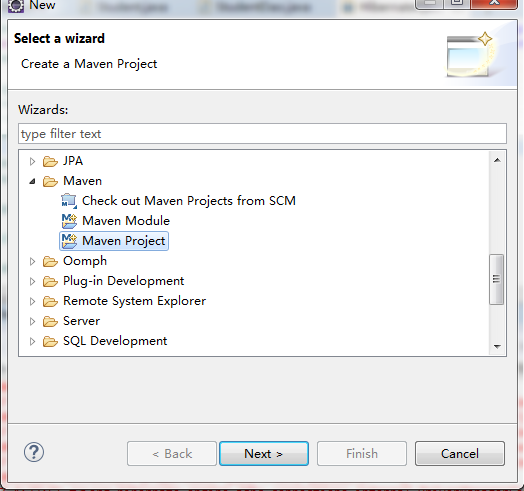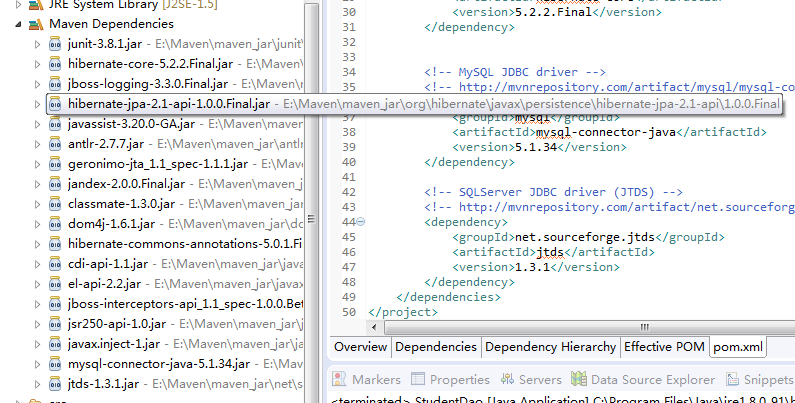使用 eclipse 来搭建的一个简易框架,用起来还是及其方便的,配置也极为简单。不过在钻研过程中,却走了很多路,这里总结一下最后成果。
首先使用要创建一个 maven project ,直接编写配置 pom.xml 自己就下载依赖了,特别好用~

然后选择工作目录:

选择模板类型:

接着下一步填写相应信息,点击 finish 就 ok 啦!
然后我们来编写 pom.xml 依赖:需要声明使用 Hibernate 5库:
<project xmlns="http://maven.apache.org/POM/4.0.0" xmlns:xsi="http://www.w3.org/2001/XMLSchema-instance" xsi:schemaLocation="http://maven.apache.org/POM/4.0.0 http://maven.apache.org/xsd/maven-4.0.0.xsd"> <modelVersion>4.0.0</modelVersion> <groupId>com.test</groupId> <artifactId>HibernateQuickStart</artifactId> <version>0.0.1-SNAPSHOT</version> <packaging>jar</packaging> <name>HibernateQuickStart</name> <url>http://maven.apache.org</url> <properties> <project.build.sourceEncoding>UTF-8</project.build.sourceEncoding> </properties> <dependencies> <dependency> <groupId>junit</groupId> <artifactId>junit</artifactId> <version>3.8.1</version> <scope>test</scope> </dependency> <!-- Hibernate Core --> <!-- http://mvnrepository.com/artifact/org.hibernate/hibernate-core --> <dependency> <groupId>org.hibernate</groupId> <artifactId>hibernate-core</artifactId> <version>5.2.2.Final</version> </dependency> <!-- MySQL JDBC driver --> <!-- http://mvnrepository.com/artifact/mysql/mysql-connector-java --> <dependency> <groupId>mysql</groupId> <artifactId>mysql-connector-java</artifactId> <version>5.1.34</version> </dependency> <!-- SQLServer JDBC driver (JTDS) --> <!-- http://mvnrepository.com/artifact/net.sourceforge.jtds/jtds --> <dependency> <groupId>net.sourceforge.jtds</groupId> <artifactId>jtds</artifactId> <version>1.3.1</version> </dependency> </dependencies> </project>
然后它会自动下载。。。:

src/main/java 下,我们需要 hibernate.cfg.xml 配置
<?xml version="1.0" encoding="UTF-8"?> <!DOCTYPE hibernate-configuration PUBLIC "-//Hibernate/Hibernate Configuration DTD 3.0//EN" "http://hibernate.sourceforge.net/hibernate-configuration-3.0.dtd"> <hibernate-configuration> <session-factory> <property name="connection.url">jdbc:mysql://localhost:3340/mydb</property> <property name="connection.driver_class">com.mysql.jdbc.Driver</property> <property name="connection.username">root</property> <property name="connection.password">111111</property> <property name="hibernate.dialect">org.hibernate.dialect.MySQLDialect</property> <property name="hibernate.show_sql">true</property> <property name="hibernate.format_sql">true</property> <mapping resource="Student.hbm.xml"/> </session-factory> </hibernate-configuration>
这里注意修改自己本地的数据库相关信息。
同级目录下还需要写一个“持久性实体类”,好像是这么叫的,反正我理解就是这个类对应了数据库中的一张表:
public class Student { private int id; private String name; public Student() {} public Student(String name, int id) { this.id = id; this.name = name; } public int getId () { return id; } public void setId (int id) { this.id = id; } public String getName () { return name; } public void setName (String name) { this.name = name; } }
接着创建一个 Student.hbm.xml 来配合实体类使用,具体可以看文档详细介绍,这里只搭个能用的环境先~
<?xml version="1.0" encoding="UTF-8"?> <hibernate-mapping> <class name="Student" table="student"> <id name="id" column="S_ID" type="int"></id> <property name="name" column="S_NAME" type="string"></property> </class> </hibernate-mapping>
在数据库创建一张对应的表:

最后,一个数据访问层的 java 类:
import org.hibernate.Session; import org.hibernate.SessionFactory; import org.hibernate.cfg.Configuration; public class StudentDao { public static void main (String[] args) { Configuration conf = new Configuration(); conf.configure("hibernate.cfg.xml"); //创建工厂 SessionFactory sf = conf.buildSessionFactory(); //取得session Session session = sf.openSession(); //开始事务 session.beginTransaction(); Student student= new Student("ice", 1); session.save(student); System.out.println("保存成功"); session.getTransaction().commit(); session.close(); sf.close(); } }
debug~